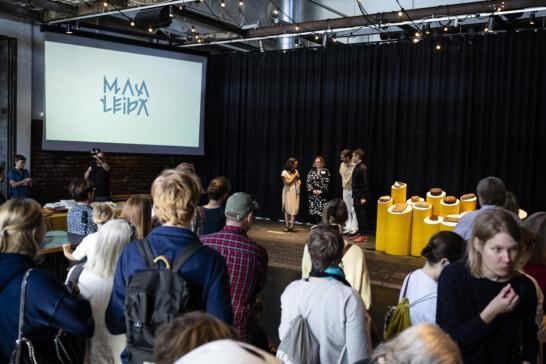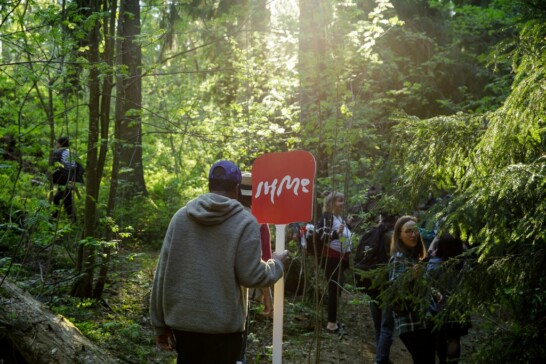Ecoblog
The digital carbon footprint of an artwork

What is art’s digital carbon footprint? At IHME Helsinki, we are committed to ecological sustainability and we calculate the carbon footprint of everything we do. IHME Helsinki Commission 2022 took the form of a digital online course. There was no available calculator for gauging the carbon footprints of digital works, and news items on the topic in recent years have been contradictory. That is why we wanted to make a thorough analysis of the digital carbon footprint of the IHME 2022 Commission – is it large or small, and how can it be reduced?
What does a digital carbon footprint consist of?
The digital carbon footprint refers to the emissions resulting from the storage, transfer and use of digital content. It includes both the carbon footprint of the electronic devices needed and the carbon footprint of the electricity used.
IHME Helsinki Commission 2022 was the online course Learning from Doubt by Indian artist Amar Kanwar. It was a hybrid production involving: a 10-week online course; a flight to Finland to meet the students in mentoring meetings; and a film screening in Helsinki. According to the Hiilifiksu järjestö’s (carbon-smart organization) calculator, the emissions from the entire production were 3500 kg of CO2e, of which the flight from New Delhi to Helsinki accounted for 89%, the film screening 3%, and the online course 7%.
The digital carbon footprint of the online course was 256 kg CO2e. Both the planning and participation in the online course were included in the calculation. The calculation incorporated not only the emissions from data storage, transfer and use, but also the carbon footprint from manufacturing the equipment.
Emissions from planning and equipment surprisingly large
The carbon footprint calculation produced a few surprises. The share of emissions from manufacturing the equipment was surprisingly large, as high as 44%. The computers used in the planning phase in India accounted for 9%, the share of laptops, smartphones and tablets used by the course participants in Finland was 35%, and emissions from the website server were 0.3% of the course’s total emissions. If you ignore the emissions from the planning phase, and only look at the carbon footprint created during the course, half of the emissions come from equipment manufacture, the other half from data transfer and electricity consumption by the equipment.
Another surprise was the large percentage from course planning. A third of the emissions occurred before the course had started. This was a consequence of both the large specific emissions from the electricity used in India and the relatively small number of participants. If there had, for example, been a hundred times as many course participants, more than 99% of the emissions would have been generated during the course, regardless of the origin of the electricity used in the planning phase.
We get another perspective if we exclude course planning and equipment manufacture from the calculation, and consider only the emissions that arise from the storage, transfer and use of digital content. In that case, data transfer makes up 84% of the emissions, electricity consumption by participants’ devices 15%, and data storage on the server the final 1% of emissions. However, data-transfer emissions (70 kg CO2e) make up only a quarter (27%) of the total carbon footprint.
Comparisons and speculation
The digital carbon footprint of the online course was a total of 256 kg CO2e. Divided between 150 participants, this makes 1.7 kg CO2e/participant. According to the “Hesburger index”, the emissions from the course correspond to the emissions from half a hamburger (the emissions of a whole hamburger being 3.4 kg CO2e). The emissions from the entire course correspond roughly to a car trip from Helsinki to Utsjoki.
If the course had been 10 weeks of classroom teaching in Helsinki, with the artist staying in accommodation for 75 euros/night and participants arriving in Helsinki from different parts of Finland, the emissions would have been at least 6,000 kg CO2e, i.e., almost double the actual amount. The same figure of 6,000 kg CO2e emissions would also have been generated if there had been 2,800 participants in the hybrid course.
Taking into account the radiative forcing from flying at high altitude, the emissions from the New Delhi-Helsinki round trip were approximately 1500–3100 kg CO2e. The course’s digital carbon footprint was 256 kg CO2e, of which participants’ equipment, data transfer and electricity consumption 171 kg, i.e. 1.14 kg CO2e/participant. Even if 1,200 or as many as 2,600 people had participated in the online course, the carbon footprint of participants’ devices, data transfer and electricity consumption would still have been smaller than the emissions from a round-trip flight.
Now that the course material has been produced, it will be reused for several years with different communities. If the course is carried out again with exactly the same content and if course participants use the same equipment and study as hard as they did now, then emissions from the next course will be 171 kg of CO2e.
How to reduce a digital carbon footprint?
Consumers and content producers can impact the size of a digital carbon footprint in various ways. Here are some of them.
When planning a virtual meeting
Can the issue be dealt with by e-mail or telephone?
Say hello through the camera, listen without the camera. Turning off the camera can reduce emissions by 96%.
Reduce the resolution.
Use a fixed Internet connection instead of a mobile network.
Use renewable electricity.
When planning to buy a computer or mobile phone
Use the device for as long as possible.
Buy used or ethically rated products.
When you no longer use the device yourself, pass it on or recycle it appropriately.
Ask the seller or manufacturer of the device how responsible use of raw materials has been ensured.
When planning or updating web pages
Decide what is the main content of the page is. Remove anything unnecessary.
Reduce and optimize video and image sizes and formats.
Reduce the amount of automatically transferred data. Give visitors the option to download content only when they want it.
Will your content run on a 10-year-old computer? Do you push users to buy new devices?
Ask the software company that codes the website to maximize the site performance and to use green code
Find out the emissions of your website.
Read more about big tech CO2 emissions.
When wishing to simply relax
Consider alternatives to social media, videos, or gaming (for example, a book, a walk, an art exhibition, or meeting a friend).
Watch only one episode. Turn off Autoplay, set a time limit for watching videos.
Share and use content thoughtfully. Heavy data content, such as a video, creates a bigger load than a simple text post. Is it even necessary to share everything?
Use a fixed Internet connection instead of a mobile network.
Reduce the resolution if possible.
Dim the backlight on the mobile device and turn off the location services and any additional background applications.
Use renewable electricity.
How was the online course’s digital carbon footprint calculated?
The calculation was made based on the following data: The online course was planned and created on four computers in India in 1280 hours. The course was attended by 150 students who each spent 10–30 hours on it. The course included 3.5 hours of online meetings and self-study on a website containing 3.5 hours of video material, 470 pages of text, as well as images and audio.
The emissions from equipment manufacture were estimated as follows: The manufacture of an average laptop generates emissions of around 300 kg CO2e. We asked course participants about the lifecycle and hours of use of their devices. Based on this data, the emissions per hour from the manufacture of the devices were calculated. The course students used their computers for considerably longer than the average Finnish consumer, and the manufacturing emissions allocated were 0.03 kg CO2e/hour of use.
This article was written by IHME’s eco-coordinator Saara Korpela based on her carbon-footprint calculation whose scope, coefficients and accuracy of have been checked by UseLess Company Oy.


